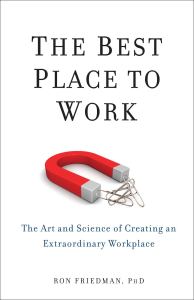The Best Place to Work
How do you create an extraordinary workplace?
How do you turn a group of strangers into a community of friends?
Why should a company pay people to play?
Usually, when I read advance copies of book manuscripts, I wait to talk about the book until it is released. In this case, I couldn’t help but talk about this book for the last few months at conferences. Now that it is finally available, I am excited to introduce Ron Friedman’s new book The Best Place to Work: The Art and Science of Creating an Extraordinary Workplace.
BOOK GIVEAWAY
For your chance to receive a free copy of Dr. Friedman’s new book, The Best Place to Work: The Art and Science of Creating an Extraordinary Workplace, do any of the following:
- Answer the question and leave a comment below.
- Tweet, Share or Like the post.
- If you are on the email list, you will also be automatically entered.
This is NOW CLOSED.
If you want to build a winning culture and encourage collaboration, this book provides a blueprint. If you are designing a new office space or updating an old one, this book is a must read. But what surprised me most about this book is the many insights it provides for leaders at all levels. If you want to be promoted at work, you will want to read this book and follow its guidelines. And, as a CEO who is privileged enough to lead an organization that regularly hits the Best Places to Work in IT list, I can tell you this book gave me numerous ideas.
The book’s author, Ron Friedman, PhD, recently answered my questions about his research and work. He is a psychologist and the founder of Ignite80, a management consultancy to help leaders build extraordinary workplaces.
3 Ways to Improve Space
From a workplace design perspective, what are the top 3 ways to improve space for a positive impact?
 The most important principle is design with the end in mind. Think carefully about the tasks your employees are going to be doing and provide a space that empowers them to do their work more effectively. At many companies, people are placed in the identical work environments regardless of their job function, and this is a missed opportunity. It’s why so many people feel that they need to come in early or stay late to get any work done.
The most important principle is design with the end in mind. Think carefully about the tasks your employees are going to be doing and provide a space that empowers them to do their work more effectively. At many companies, people are placed in the identical work environments regardless of their job function, and this is a missed opportunity. It’s why so many people feel that they need to come in early or stay late to get any work done.
A second consideration is encouraging people to personalize their workspace. In The Best Place to Work I talk about organizations like Etsy and DreamWorks that provide their employees with a budget for customizing their workspace when they first join. It’s a wise strategy. When we have the freedom to shape our environment, we experience a sense of personal control. One study found that people are over 30% more effective when they’re encouraged to personalize their workspace.
A third recommendation is to invest in informal social spaces, like outdoor picnic tables or a café-like break room. The idea is to encourage colleagues to get together, even when they’re not talking about work. Workplace friendships are vital to our performance, and lasting friendships aren’t established when we’re in formal meetings.
Paid to Play?
One of your chapters says that we should be paid to play. You say that the childlike manner of play can improve our creativity. How can we use play and exercise to improve our workplace?
There’s a business case for giving employees the flexibility they need to exercise. Over the last decade, scientists have uncovered a range of benefits from regular workouts that extend far beyond being healthy or looking good. Exercise, research tells us, can also make us more effective at work.
Exercise gets more blood flowing to the brain, improving our focus. It stimulates memory regions of the brain, making us faster learners. After working out, people’s mood improves, which is vital for collaboration and dealing with customers.
I also talk about the benefit of creating a playful mindset in the workplace as a means of promoting creativity. Empowering employees to pursue tangential interests, even if they’re not immediately relevant to an assignment, fosters a sense of curiosity and learning that can benefit a company’s performance.
My favorite way of implementing this approach is to provide every employee with a reading budget. Creativity, as Steve Jobs famously said, is simply connecting things. The more perspectives we’re exposed to, the more likely we are to come up with novel solutions.
Good Friend at Work = Higher Job Satisfaction
Having a good friend at work is a factor in job satisfaction. I was fascinated with your research on making friends. Would you share what you discovered about physical proximity and familiarity?
We have decades of research on the factors that lead strangers to develop close friendships. One of the major contributors is physical proximity, which refers to how often you see another person. The more we see someone, the more familiar they become, and the more we tend to like them.
It’s an unconscious process. There’s an uncertainty we feel upon meeting someone for the first time. But with repeated exposure we develop a sense of safety and comfort around them.
This explains why you’re more likely to be friends with the person in the office next door than a colleague who sits on another floor.
How to Turn an Acquaintance into a Friend
Based on this, what’s the best way to turn an acquaintance into a friend?
What the research on proximity tells us is that people are more likely to become friends when they have frequent interactions. Within many workplaces, interactions with people outside a given department are rare.
One way of applying the insights on proximity is creating opportunities for colleagues to interact with one another in cross-departmental activities, like an office-sponsored sports league or volunteer opportunities. We tend to bond when we are physically near others and working toward shared goals.
The Importance of Autonomy
How important is workplace autonomy and how do we help foster it?
Autonomy is a fundamental psychological need. To be at our most passionate and productive, experiencing autonomy is vital.
In the book, I outline a number of ways managers can help their employees feel autonomous. Among them are (1) providing a meaningful rationale when presenting an assignment that explains why the work your team is about to do has value, (2) outlining the goals of a project and inviting employees to recommend a process for achieving those objectives, and (3) asking open-ended, clarifying questions that put the employee in control of the conversation. For example, instead of asking, “Do you have everything you need to move ahead?” (prompting a yes or no response) ask, “What can I do to help you lead this?”
Is there an example you can share of a company who is doing it right, creating an extraordinary culture and workplace?
It’s impossible to assess a workplace experience from outside an organization, but there are some companies that have adopted practices that, in many ways, are ahead of their time:
- Incorporating exercise into the workplace: Radio Flyer rewards employees for exercising by providing a monthly mileage reimbursement to those who ride their bikes to work.
- Creating opportunities for restorative experiences: Huffington Post invites employees to restock their mental energy by providing a futuristic “nap capsule,” complete with a reclining chair, ambient sounds, and an alarm that gently rocks you awake after 20 minutes.
- Encouraging employees to take “real” vacations: Full Contact, a software company in Denver, awards a $7,500 bonus to employees who don’t check their email on vacation.
All of these practices do something critical: They acknowledge the fact that employees are not computers. They’re human. And as humans, we all need exercise, sleep, and the ability to connect in order to perform at our best.
 Some organizations and leaders mean well when they try to start a program to improve culture, but it doesn’t work. What do you think many companies are getting wrong?
Some organizations and leaders mean well when they try to start a program to improve culture, but it doesn’t work. What do you think many companies are getting wrong?
A common misconception I encounter is this idea that you can change a company culture by adopting an ambitious mission statement or a new set of values.
Ultimately, company culture is shaped by the behaviors of an organization’s leaders. If you’re looking to redefine how an organization operates, you need to identify a specific set of behaviors that enable leaders to demonstrate that these outcomes are important.
If you say you value work-life balance and then email your employees at all hours of the weekend, then there is an obvious inconsistency between what you say and what you do. When that happens, it’s the behavior that wins out, not the company values.
In my book, I discuss research from MIT on specific leadership behaviors that shape company culture.
The Importance of Light
What was the most surprising finding from your research into what makes an extraordinary workplace?
There was a lot here that surprised me, and keep in mind, I’ve been studying this research for over a decade.
To me, the most unexpected finding was how much natural sunlight affects our workplace performance. Studies show that people who sit near a window are better at staying on task and are more productive. There is also research showing that you can predict how satisfied people are with their job by the amount of sunlight entering their office floor. It’s because sunlight affects our body’s production of serotonin (which puts us in a good mood) and melatonin (which helps us to sleep at night).
What this highlights for me is just how much more we have to learn about the factors that truly contribute to our performance at work. If you ask people what would make them happier at work, many people would say a higher salary. How many people would say a bigger window?
The Best Place to Work: The Art and Science of Creating an Extraordinary Workplace

